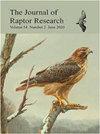Ordinal Date and Tree Diameter Influence Swallow-Tailed Kite (Elanoides forficatus) Nest Survival
IF 1.2
4区 生物学
Q2 ORNITHOLOGY
引用次数: 0
Abstract
ABSTRACT. Swallow-tailed Kites (Elanoides forficatus) continue to rebound from population declines during the late 19th and early 20th centuries, and they are considered a species of concern in several southeastern states in the United States. During 2018–2019, we located and monitored 132 active Swallow-tailed Kite nests in and around the Corkscrew Regional Ecosystem Watershed Wildlife and Environmental Area in southwest Florida, USA, to determine how nest site characteristics affect nest survival. Including both years, the earliest active nest (with eggs or young) was discovered on 12 March and the latest nest fledged young on 23 July. Modeled survival of nests from the onset of incubation to fledging was 57.7% (95% CI: 44.5–68.9) and apparent nest survival was 48.7%. Daily survival rate was negatively correlated with ordinal date. Consequently, nests initiated early in the nesting season (mid-March) were more than three times as likely to fledge young as nests initiated late in the season (mid-May). Daily nest survival was positively correlated with nest tree diameter at breast height, indicating that Swallow-tailed Kites had greater nest survival when using larger, more mature trees. We found 99.0% (n = 102) of Swallow-tailed Kite nests in south Florida slash pine (Pinus elliottii var. densa) trees and one nest in bald cypress (Taxodium distichum). Trees used for nesting in our study area were among the largest nest trees reported for the species. Our results suggest that the large pine trees and large cypress trees formerly available in old growth bottomland hardwoods and lowland pine forests of the United States may have provided superior nesting opportunities for Swallow-tailed Kites. RESUMEN. Elanoides forficatus continúa recuperándose de las disminuciones poblacionales ocurridas a fines del siglo XIX y principios del XX y se considera una especie de preocupación en conservación en varios estados del sureste de los Estados Unidos. Durante 2018–2019, localizamos y seguimos 132 nidos activos de E. forficatus, dentro y en la periferia del Área de Vida Silvestre y Medio Ambiente de la Cuenca del Ecosistema Regional Corkscrew en el suroeste de Florida, EEUU, con el fin de determinar cómo las características del sitio de anidación afectan la supervivencia de los pollos en el nido. Incluyendo ambos años, nuestro primer nido activo (con huevos o crías) fue descubierto el 12 de marzo y el último volantón dejó el nido el 23 de julio. La supervivencia modelada de los nidos desde el inicio de la incubación hasta el emplumamiento fue del 57.7% (IC al 95%: 44.5–68.9) y la supervivencia aparente del nido fue del 48.7%. La tasa de supervivencia diaria se correlacionó negativamente con la fecha ordinal. En consecuencia, los nidos iniciados temprano en la temporada de anidación (mediados de marzo) tuvieron una probabilidad tres veces mayor de generar jóvenes volantones que los nidos iniciados al final de la temporada (mediados de mayo). La supervivencia diaria del nido se correlacionó positivamente con el diámetro del árbol, medido a la altura del pecho, donde se ubicó el nido, lo que indica que E. forficatus tuvo una mayor supervivencia de pollos en el nido cuando usó árboles más grandes y maduros. Encontramos el 99.0% (n = 102) de los nidos de E. forficatus en pinos (Pinus elliottii var. densa) del sur de Florida y un nido en un ciprés calvo (Taxodium distichum). Los árboles utilizados para anidar en nuestra área de estudio se encuentran entre los árboles de anidación más grandes reportados para la especie. Nuestros resultados sugieren que los pinos y los cipreses grandes que antes estaban disponibles en los bosques maduros inundables de maderas duras y en los bosques de pinos de tierras bajas de Estados Unidos pueden haber proporcionado mejores oportunidades de nidificación para E. forficatus. [Traducción del equipo editorial]日期顺序和树径对燕尾鸢巢生存的影响
摘要燕尾鸢(Elanoides forficatus)在19世纪末和20世纪初的数量下降中继续反弹,在美国东南部的几个州,它们被认为是一个值得关注的物种。在2018-2019年期间,我们在美国佛罗里达州西南部的Corkscrew区域生态系统流域野生动物和环境区及其周围定位并监测了132个活跃的燕尾风筝巢穴,以确定巢穴地点特征如何影响巢穴生存。包括这两年在内,最早的活动巢(有蛋或幼鸟)是在3月12日发现的,最近的巢是在7月23日发现的。巢从孵化开始到羽化的模型存活率为57.7% (95% CI: 44.5-68.9),表观存活率为48.7%。日存活率与顺序日期呈负相关。因此,在筑巢季节早期(3月中旬)筑巢的巢孵出雏鸟的可能性是在筑巢季节后期(5月中旬)筑巢的巢的三倍多。巢日存活率与胸高处巢树直径呈正相关,表明使用更大、更成熟的树时,燕尾鸢的巢存活率更高。在南佛罗里达的湿球松(Pinus elliottii var. densa)上发现99.0% (n = 102)的燕尾鸢巢,在秃柏树(Taxodium distichum)上发现1个燕尾鸢巢。在我们的研究区域用于筑巢的树木是该物种报道的最大的筑巢树之一。我们的研究结果表明,以前生长在美国低洼阔叶林和低地松林中的大松树和大柏树可能为燕尾鸢提供了优越的筑巢机会。RESUMEN。Elanoides forficatus连续recuperandose de las disminuciones poblacionales ocurridas罚款del第十九siglo y principios del XX y se推崇una especie各类estado de preocupacion en conservacion en del sureste de los美国。2018-2019年,在美国佛罗里达州的调查中,环境科学与环境研究中心(环境科学与环境研究中心),环境科学与环境研究中心(环境科学与环境研究中心),环境科学与环境研究中心(环境科学与环境研究中心),环境科学与环境研究中心(环境科学与环境研究中心)。包括endendo ambos años, nuestro primer nido activo (con huevos o crías) fudecubierto el 12 de marzo和el último volantón dejó el nido el 23 de julio。La supervivencia modelada de los nidos des inicio de La incubación hasta el emplumamiento fute del 57.7% (IC 95%: 44.5-68.9), La supervivencia aparente del nidote del 48.7%。La tasa de supervivencia diaria se correlacionó negative - vamente con La fecha ordinal。En consecuencia, los nidos iniciados temprado En la temporada anidación (mediados de marzo), tuvieras unprobabilidad tres es mayor de generes jóvenes火山爆发,los nidos iniciados al final de la temporada (mediados de mayo)。全国人民的生活状况监测correlacionó diámetro全国人民的生活状况监测árbol,全国人民的生活状况监测diámetro全国人民的生活状况监测árbol,全国人民的生活状况监测diámetro全国人民的生活状况监测usó árboles más全国人民的生活状况监测。(n = 102)对佛罗里达南部的松(Pinus elliottii var. densa)和对西部的松(Taxodium distichum)有99.0% (n = 102)的污染。Los árboles use zados para anidar en nuestra área de estudio se encuentran entre Los árboles de anidación más grandes reportados para la especie。新结果表明,新结果表明,新结果表明,新结果表明,新结果表明,新结果表明,新结果表明,新结果表明,新结果表明,新结果表明,新结果表明,新结果表明,新结果表明,新结果表明,新结果表明,新结果表明,新结果表明,新结果表明,新结果表明,新结果表明,新结果表明,新结果表明,新结果表明,新结果表明,新结果表明,新结果表明,新结果表明,新结果表明,新结果表明,新结果表明,新结果表明,新结果表明,新结果表明,新结果表明,新结果表明,新结果表明,新结果表明,新结果表明,新结果表明,新结果表明,新结果表明,新结果表明,新结果表明,新结果表明,新结果表明,新结果表明,新结果。[Traducción del equipo社论]
本文章由计算机程序翻译,如有差异,请以英文原文为准。
求助全文
约1分钟内获得全文
求助全文
来源期刊

Journal of Raptor Research
生物-鸟类学
CiteScore
2.30
自引率
17.60%
发文量
61
审稿时长
>12 weeks
期刊介绍:
The Journal of Raptor Research (JRR) is an international scientific journal dedicated entirely to the dissemination of information about birds of prey. Established in 1967, JRR has published peer-reviewed research on raptor ecology, behavior, life history, conservation, and techniques. JRR is available quarterly to members in electronic and paper format.
 求助内容:
求助内容: 应助结果提醒方式:
应助结果提醒方式:


